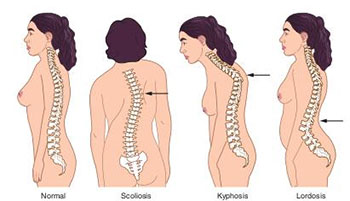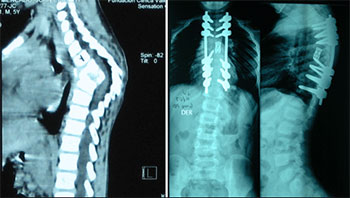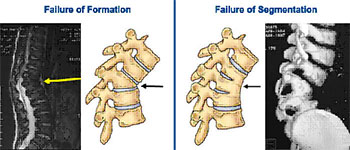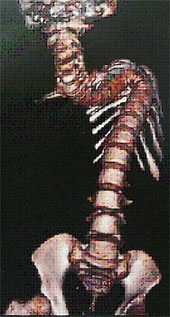Scoliosis insinuates a S-framed or C-formed spinal bending in the coronal plane (when looking at the person).
Kyphosis is used to delineate the condition of extended forward spinal angulation in the sagittal plane (looking at someone from the side). Patients may make scoliosis or kyphosis spinal distortions in adulthood, or the twisting may have been accessible since pre-adulthood and end up being consistently more unpleasant. Generally, a smooth scoliosis and/or kyphotic shape don't realize basic pain or powerlessness. In any case, when the twisting is dynamic and/or associated with other spinal conditions, it may realize pain and impair, and oblige wide treatment.


Exactly when the kyphotic deformation has get the chance to be great (more noticeable than 80s) and the patient is frequently experiencing extended back pain, surgical treatment may be recommended. Pedicle screws are put (2 for each level) and joined with two shafts. This methodology grants sensitive altering of the spine. Most surgeries are performed from the back. In any case, a couple specialists endorse additional surgery on the front of the spine. Patients are for the most part prepared to return to standard consistently practices within 4-6 months taking after surgery.
Essentially, the patient’s head should be balanced over the sacrum and pelvis when looking at the patient from the front viewpoint and the side point of view. The spinal rhythmic movement in the adult is from time to time as versatile as that of an adolescent or adolescent, along these lines a front discectomy and release (passage point through the stomach zone or midsection zone) or a back osteotomy (cutting through the spine bone using the back cut) must be performed to support attractive change of the deformation.
Pain in standing is the most well-known indications of patients with an extreme spinal disfigurement. Patients regularly feel as on the off chance that they may be "cockeyed," which happens in light of the fact that their head and middle is as often as possible moved forward and/or to the side. Patients might likewise have sciatica, neurogenic claudication, and leg indications if there is related spinal stenosis.


The treatment of grown-up patients with scoliosis and/or kyphosis relies on upon the seriousness of the pain, nerve pressure, and spinal distortion. A patient age and general restorative condition additionally is an imperative thought, subsequent to the surgical medications are frequently expansive operations. Almost all patients are prescribed for traditionalist treatment at first unless there is a serious neurologic deficiency, for example, leg shortcoming and deadness. Active recovery, chiropractic consideration and oral pharmaceuticals (non-steroidal mitigating solutions, pain drugs, and muscle relaxant meds) are every now and again endorsed. Epidural steroid infusions and/or nerve root squares might likewise be used for serious pain or moderate agony that is no more reacting to other preservationist measures. Patients who come up short these progressive measures are typically contender for surgical mediation.
A basic part of surgical choice making is to figure out what is bringing about the patient’s distress and incapacity. Infrequently, a scoliosis patient may have one central district of nerve pressure or stenosis, which may be treated by a little minute decompression surgery without rectification of the spinal deformation. Be that as it may, if there is critical spinal irregularity bringing on trouble strolling and standing, a distortion redress ought to be performed in order to address this issue. The surgical treatment of grown-up scoliosis and/or kyphosis is spinal combination (patching the spine bones together) with instrumentation (metal bars and screws).